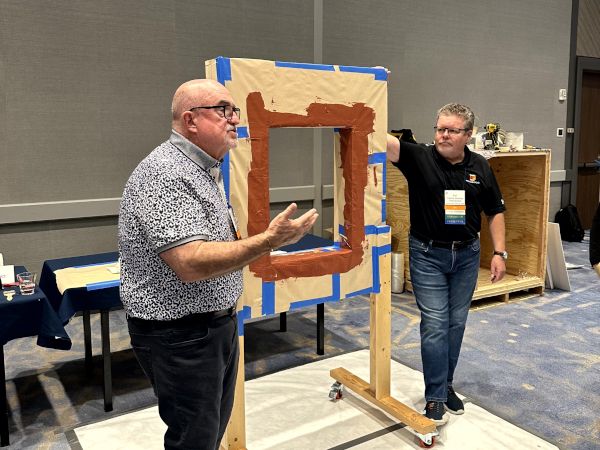
Date: 25 September 2024
Several training and education opportunities took place during the Fenestration and Glazing Industry Alliance (FGIA) 2024 Fall Conference in Minneapolis, MN, including an informative session on mockup testing in construction, a primer on corrosion and an educational hands-on workshop demonstrating proper application of materials common in fenestration installation, as presented by the FGIA Wall Interface Council.
Construction Mockups and Testing
A presentation entitled "Construction Mockups & Testing | Overview, Trends, and Best Practices" was led by Christopher Grey, a principal in the Simpson Gumpertz & Heger (SGH) Building Enclosures Division in Boston, MA. “Mockups allow you to understand real-life conditions and enforce lessons learned throughout,” said Grey. “You can work out bugs early.”
Grey shared that there are several different types of construction mockups, including laboratory (off site), preconstruction (standalone), in-situ (on-building) and digital. Laboratory ones are typically for unique systems. “A laboratory mockup can help one identify water leakage locations so one can find the cause and course correct,” said Grey. With standalone mockups, one can customize small and large projects and conduct smaller scale tests on or near site. “You can understand visual versus performance and meet specific jurisdictional requirements,” said Grey. “You can test the fenestration products, the wall assembly and cladding and the entire mockup.” In-situ mockups are for all project types and smaller scale tests with unique conditions on the building. Finally, digital mockups are also for all project types. They vary in size and use. “There is no performance testing available yet, but you can use this to try out unique conditions,” said Grey.
Mockups can help you understand real life conditions. “They are not just a quality assurance program,” said Grey. When implementing mockups, be vigilant throughout, starting early, he added. “Specify and detail mockups in documents,” Grey advised. “Get your contractor's advice. Use available tools to mitigate potential risk at various phases of a project.”
Introduction to Corrosion
Another session called "Introduction to Corrosion" was presented by Dr. Victoria Gelling, Senior Research Fellow at Sherwin-Williams. She shared the science behind how corrosion is caused. “How do we stop corrosion? We don't,” she said. “But coatings can slow water, salts and oxygen from reaching the surface of the metal. All non-noble metals will eventually corrode.”Corrosion is an electrochemical process occurring at metal/electrolyte interface, explained Gelling. “Think of it as refining in reverse,” she said. “To stop corrosion, stop having a place for those electrons to go.” Multiple factors impact corrosion rates, including pH, oxygen availability, salts, contaminants, temperature, oxide layer properties, applied potential (voltage) and time of wetness. Important factors are pH, oxygen and temperature. “Steel doesn't care what pH you're at,” she said, adding that “changes in pH of an electrolyte will not impact corrosion rate of iron as much as it will the corrosion rate of aluminum alloys.”
In conclusion, corrosion and its accurate measurement is a complex subject, said Gelling. “It's a constantly evolving area, with new materials, substrates, pretreatments and industry needs entering the marketplace.”
Wall Interface Hands-on Workshop
A hands-on workshop demonstrated six different processes thanks to volunteers from five companies, all of whom displayed the proper process of applying materials during fenestration installation:
- Proper application of liquid applied flashing – Pat Downey (PROSOCO)
- Compatibility of materials and common signs of incompatibility – Guy Long (PROSOCO)
- Flashing application focused on weatherboard sequencing – Rod Calkum (Aquatech Consultancy, Inc.)
- Proper use of a J-Roller for self-adhering flashing – Eric Seaverson (Intertek)
- Sealant joints, types of joints, proper joint design – Bill Longo (DAP Global, Inc.)
- Gunnable sealant and quality control for mixing two-component sealants – Steve Altum (Dow Performance Silicones)
For more information about FGIA and its activities, visit FGIAonline.org.
 600450
600450









Add new comment